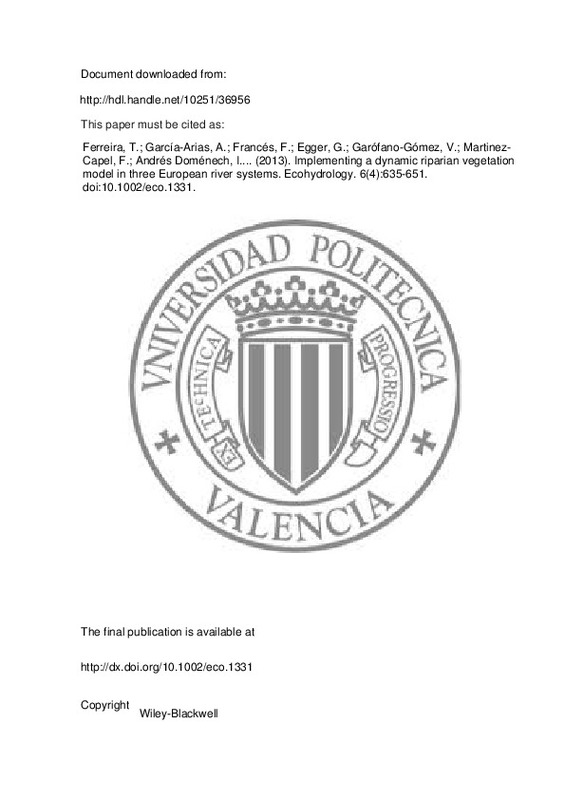JavaScript is disabled for your browser. Some features of this site may not work without it.
Buscar en RiuNet
Listar
Mi cuenta
Estadísticas
Ayuda RiuNet
Admin. UPV
Implementing a dynamic riparian vegetation model in three European river systems
Mostrar el registro sencillo del ítem
Ficheros en el ítem
| dc.contributor.author | García-Arias, Alicia
|
es_ES |
| dc.contributor.author | Francés García, Félix Ramón
|
es_ES |
| dc.contributor.author | Ferreira, T.
|
es_ES |
| dc.contributor.author | Egger, G.
|
es_ES |
| dc.contributor.author | Martinez-Capel, Francisco
|
es_ES |
| dc.contributor.author | Garófano-Gómez, Virginia
|
es_ES |
| dc.contributor.author | Andrés Doménech, Ignacio
|
es_ES |
| dc.contributor.author | Politti, Emilio
|
es_ES |
| dc.contributor.author | Rivaes, R.
|
es_ES |
| dc.contributor.author | Rodriguez-Gonzalez, P.M.
|
es_ES |
| dc.date.accessioned | 2014-04-10T09:56:30Z | |
| dc.date.issued | 2013 | |
| dc.identifier.issn | 1936-0584 | |
| dc.identifier.uri | http://hdl.handle.net/10251/36956 | |
| dc.description.abstract | Riparian ecosystems are required to be preserved to achieve a good ecological status. The Water Framework Directive (2000/60/EC) specifically supports the assessment of new management tools that allow the European Member States to achieve good ecological status of river-related ecosystems. Within several approaches, a dynamic riparian vegetation distributed model (CASiMiR-vegetation), with a time step of 1 year, has been selected as a useful first-step tool to achieve the Water Framework Directive requirements. The model has been implemented into three river reaches with different climatic and hydrologic settings, located in three European countries. Common bases were established in the model setup. The model was calibrated independently in the Kleblach reach (Drau River, Austria), the Ribeira reach (Odelouca River, Portugal), and the Terde reach (Mijares River, Spain) with simulation periods of 8, 11 and 41 years, respectively. The parameter values and the results were comparable between the different countries. The calibration performance achieved high correctly classified instances (60%). Additionally, weighted kappa values ranged from 0·52 to 0·66 in distinguishing riparian succession phases. The model behaved similarly in the validation, even offering better results in most cases. This work demonstrates the applicability of this model in the simulation of the riparian vegetation dynamic distribution over a wide range of environments. As it performs in a robust manner and with good results in reaches with different hydrological characteristics, the model could be also applied to analyse different hydrological scenarios or to predict changes after restoration measures within a reach. Copyright © 2012 John Wiley & Sons, Ltd. | es_ES |
| dc.description.sponsorship | The Austrian team would like to thank the Lebensministerium (Austrian Ministry of Environment) and Professor Helmut Habersack and his group from the University of Natural Resources and Life Science Vienna for the supply of the hydrological data. The Portuguese team would like to thank Antonio Pinheiro for his supervision of the hydraulic modelling. The hydrological data were supplied by the Portuguese National Hydrologic Resource Information System (SNIRH) and aerial photographs by the Portuguese Geographic Institute (IGP) under the FIGIEE programme. Patricia M. Rodriguez-Gonzalez benefited from a postdoctoral grant from FCT (SFRH/BPD/47140/2008). Antonio Albuquerque was a valuable assistant in field work. The Spanish team would like to thank in addition the Hydrological Studies Centre (CEH-CEDEX), the Jucar River Basin Authority (CHJ) and the Spanish National Geographic Information Centre (CNIG) for supplying the hydrological data and the aerial photographs for the Spanish study site. | en_EN |
| dc.language | Inglés | es_ES |
| dc.publisher | Wiley-Blackwell | es_ES |
| dc.relation.ispartof | Ecohydrology | es_ES |
| dc.rights | Reserva de todos los derechos | es_ES |
| dc.subject | Riparian vegetation | es_ES |
| dc.subject | Succession/retrogression | es_ES |
| dc.subject | Dynamic modelling | es_ES |
| dc.subject | Model implementation | es_ES |
| dc.subject | River systems management | es_ES |
| dc.subject.classification | INGENIERIA HIDRAULICA | es_ES |
| dc.subject.classification | TECNOLOGIA DEL MEDIO AMBIENTE | es_ES |
| dc.title | Implementing a dynamic riparian vegetation model in three European river systems | es_ES |
| dc.type | Artículo | es_ES |
| dc.embargo.lift | 10000-01-01 | |
| dc.embargo.terms | forever | es_ES |
| dc.identifier.doi | 10.1002/eco.1331 | |
| dc.relation.projectID | info:eu-repo/grantAgreement/MICINN//CGL2008-03076-E/ES/IWRM-NET - MODELACION DE LA VEGETACION DE RIBERA PARA LA DETERMINACION DE REGIMENES DE CAUDALES ECOLOGICOS/ | es_ES |
| dc.relation.projectID | info:eu-repo/grantAgreement/MICINN//CSD2009-00065/ES/Evaluación y predicción de los efectos del cambio global en la cantidad y la calidad del agua en ríos ibéricos/ | es_ES |
| dc.relation.projectID | info:eu-repo/grantAgreement/FCT//SFRH/BPD/47140/2008/ | es_ES |
| dc.rights.accessRights | Abierto | es_ES |
| dc.contributor.affiliation | Universitat Politècnica de València. Departamento de Ingeniería Hidráulica y Medio Ambiente - Departament d'Enginyeria Hidràulica i Medi Ambient | es_ES |
| dc.contributor.affiliation | Universitat Politècnica de València. Instituto de Investigación para la Gestión Integral de Zonas Costeras - Institut d'Investigació per a la Gestió Integral de Zones Costaneres | es_ES |
| dc.description.bibliographicCitation | García-Arias, A.; Francés García, FR.; Ferreira, T.; Egger, G.; Martinez-Capel, F.; Garófano-Gómez, V.; Andrés Doménech, I.... (2013). Implementing a dynamic riparian vegetation model in three European river systems. Ecohydrology. 6(4):635-651. https://doi.org/10.1002/eco.1331 | es_ES |
| dc.description.accrualMethod | S | es_ES |
| dc.relation.publisherversion | http://dx.doi.org/10.1002/eco.1331 | es_ES |
| dc.description.upvformatpinicio | 635 | es_ES |
| dc.description.upvformatpfin | 651 | es_ES |
| dc.type.version | info:eu-repo/semantics/publishedVersion | es_ES |
| dc.description.volume | 6 | es_ES |
| dc.description.issue | 4 | es_ES |
| dc.relation.senia | 248658 | |
| dc.contributor.funder | Ministerio de Ciencia e Innovación | es_ES |







![[Cerrado]](/themes/UPV/images/candado.png)

